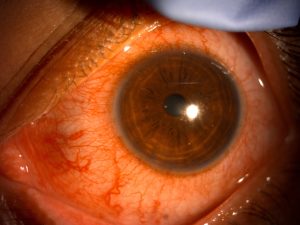Conjunctivitis
It seems the #conjunctivitis (آشوب چشم) epidemic is back!
Adenovirus conjunctivitis, commonly known as “pink eye”, is a viral infection affecting the conjunctiva – the transparent membrane covering the eye and the inside of the eyelids. This informative leaflet aims to provide insights on its symptoms, complications, treatment, and methods of transmission in a question-answer format.
What is conjunctivitis?
Viral conjunctivitis is the most common cause of an acute red eye. A self-limited infection, it usually resolves within a week and leaves no permanent damage. It spreads by contact; contagiousness varies with the viral species. Preschoolers and school-age children get it most often because of crowding and lack of good hand washing and hygiene.
Caused most often by adenovirus, it cannot be treated effectively with antimicrobial agents. Instead, management is directed at scrupulous hygiene to prevent spread, which is most likely when discharge is present. Wearing dark glasses, a common practice in #Karachi, does not prevent the spread of the virus.
What are the common symptoms of conjunctivitis?
Patients with adenovirus conjunctivitis often experience the following symptoms:
- Redness in one or both eyes.
- Watery discharge, often mistaken for tears.
- Itchiness or burning sensation in the eyes.
- Sensitivity to light or photophobia.
- A feeling of grittiness or having a foreign body in the eye.
- Swelling of the eyelids.
- Blurred vision, mainly due to the discharge.
- Lymph node enlargement near the ears or neck, signalling an immune response.
Vision is usually normal unless mucus gets on the cornea, which can be blinked away. One or both eyes may be involved. There may be an ongoing or preceding upper respiratory infection or a history of recent exposure to someone with a red eye.
The irritation and discharge may get worse for three to five days before getting better, and symptoms can persist for two to three weeks. If in doubt, it is advised you see an eye specialist.
How is conjunctivitis spread?
The transmission of adenovirus conjunctivitis occurs primarily through:
Direct contact: Touching an infected person’s eyes or objects/surfaces they’ve touched, and then touching one’s own eyes.
Respiratory droplets: Coming into contact with respiratory secretions from an infected individual, such as through sneezing or coughing.
Shared items: Using items like towels, eye makeup, or eye care products of an infected person.
Public places: Swimming in contaminated pools or using shared eyewear.
Note that adenovirus conjunctivitis is highly contagious, making preventive measures crucial.
What are the treatment options to relieve symptoms?
While there’s no specific antiviral treatment for adenovirus conjunctivitis, various interventions can alleviate symptoms:
Cold compresses: Applying a cold, damp cloth to closed eyes 4-6 times daily can help reduce inflammation and comfort.
Artificial tears: Over-the-counter lubricating eye drops can relieve dryness and the gritty sensation. Ensure the product is preservative-free to avoid potential irritants.
Antihistamine or anti-inflammatory eye drops: These can reduce itching and inflammation. They should be used under the guidance of an ophthalmologist.
Avoid wearing contact lenses: While infected, refrain from using contacts. It’s advisable to discard disposable lenses or thoroughly clean extended-wear lenses before reuse.
Topical antibiotics: They’re not effective against viruses but might be prescribed if there’s a bacterial co-infection.
Remember, never use medication eye drops from a previous eye condition or those prescribed to someone else.

Are there complications associated with adenovirus conjunctivitis?
In the majority of cases, adenovirus conjunctivitis is a self-limiting condition and resolves without complications. However, some potential complications include:
Keratoconjunctivitis: A more severe form of conjunctivitis that also involves the cornea. This can lead to blurred vision and may last for several weeks.
Chronic eye dryness: Some patients may experience prolonged dry eye symptoms even after the infection subsides.
Corneal scarring: In rare cases, inflammation can lead to scarring on the cornea, affecting vision.
How can the spread of adenovirus conjunctivitis be prevented?
Prevention hinges on maintaining hygienic practices:
Regular handwashing: Use soap and water for at least 20 seconds, especially after touching the eyes.
Avoid touching the face: Refrain from touching your eyes, nose, and mouth with unwashed hands.
Use personal items: Don’t share towels, pillows, cosmetics, or eye care items.
Clean surfaces: Disinfect frequently touched objects and surfaces.
Stay home if infected: Limit your interaction with others when you have conjunctivitis to prevent its spread.
Quarantine: stay away from communal activities—work, school, daycare—as long as discharge is present.
Conclusion
Adenovirus conjunctivitis, while uncomfortable, is typically a short-lived condition. Awareness of its transmission methods and maintaining hygienic practices can effectively reduce its spread. If you suspect you have adenovirus conjunctivitis, it’s crucial to seek guidance from a healthcare professional, preferably an ophthalmologist, to ensure proper care and prevent complications.
Source: http://www.aao.org/theeyeshaveit/red-eye/viral-conjunctivitis.cfm


